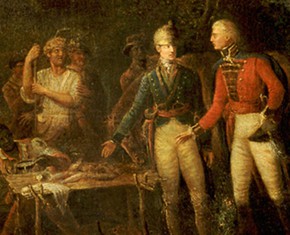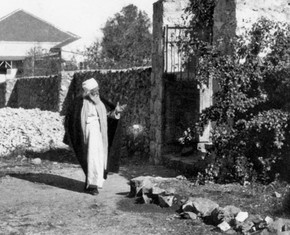The views expressed in our content reflect individual perspectives and do not represent the authoritative views of the Baha'i Faith.
On May 16, 1914, Abdu’l-Baha stepped off a train at Es Samakh, at the southern end of the Sea of Galilee, accompanied by His friend Zaki Bey, the Military Commander of Jerusalem.
A group of farmers from the Baha’i village of Adasíyyih were there to greet them. They had brought horses. Abdu’l-Baha mounted up and set out for the village in a party of twenty horsemen.
RELATED: Learning from Abdu’l-Baha’s Commitment to Service
After riding through fields of grain for close to an hour, reported Abdu’l-Baha’s secretary, suddenly Arab horsemen came out from behind thick brush woods and started a lively race with drawn swords:
It was a spectacular sight! They played and raced their horses until they reached the garden of Adasíyyih. All the Baha’is were in front of the gate to welcome the Master [Abdu’l-Baha] for His first visit. He alighted from his horse and toured the farm. Later, sitting under the shade of the apricot trees in front of a flowing stream, tea was served to everyone.
The image is idyllic, but the farmers who had established the village in what was then Palestine and is now Jordan were engaged in an arduous struggle to revive the land that Abdu’l-Baha had purchased in 1901. The first two attempts at farming failed: the neglected land was covered with thorny scrub brush, and the meager crops the land first produced had been looted by thieves.
Abdu’l-Baha understood the vital importance of agriculture. His father Baha’u’llah, the prophet and founder of the Baha’i Faith, wrote that among the fundamental principles for the administration of human affairs, “Special regard must be paid to agriculture.” In 1908 Abdu’l-Baha contacted the Baha’is of Tehran and asked them to send experienced farmers to establish a farming community. In all, some 20 families, Baha’is of Zoroastrian background from around Yazd in Persia, emigrated to Adasíyyih.
At first, they built simple huts and labored with hand tools to clear the land. They initially planted grain, but Abdu’l-Baha soon encouraged them to diversify into fruit trees, vegetables, and livestock, more lucrative, sustainable, and regenerative options. By the middle of WWI, the farmers were in a position to send camel trains of grain to the Haifa-Akka area, helping to avert a war-time famine — for which Abdu’l-Baha was knighted by the British Empire in 1920.
Abdu’l-Baha visited the Adassiyih farm four times but also spent additional time in the Galilee area, befriending officials and community leaders to ensure that the villagers at Adasíyyih, and four other villages in the area owned by Baha’is, would be safe and accepted by their neighbors.
Abdu’l-Baha owned the land and had established a tenancy arrangement that was more generous to the farmers than was typical of that time and place. In turn, he encouraged the Baha’is to treat their Arab neighbors fairly, and in a highly unusual move for the time, to give those who worked for them a share of any profits from the farming ventures.
Although as a child he often accompanied his father Baha’u’llah as he managed his farming estates in Persia, Abdu’l-Baha had been an exile and prisoner since the age of eight, in 1852. However, released from prison after the Young Turk rebellion in 1908, Abdu’l-Baha was able to serve as the main agricultural advisor to the community, providing information about crop choices and growing methods. As just one example, Abdu’l-Baha provided the first banana suckers — a gift given to him by Baha’i pilgrims from India — and explained how to grow them. This novel crop became a major source of income for farmers in the Jordan Valley.
After Abdu’l-Baha passed away in 1921, the Adassiyih community elected a Spiritual Assembly, one of the first Baha’i administrative institutions in the world. It established committees to organize farming activities and community life and built an impressive Baha’i administrative center (called a Haziratu’l-Quds) there in 1931.
By that time, Adassiyih had become a showplace for the whole of Jordan. Whenever the government wished to show how advanced the nation was in agricultural production and rural development, it would bring foreign guests and dignitaries to Adasíyyih. Government representatives would point out the mixed operation — grain and vegetables, orchards and banana plantations, and livestock — which stood out in an otherwise arid scrubland. Adasíyyih was particularly well known for its tree crops, including many varieties of citrus, and farmers would come from around the area to obtain cuttings.
Visitors appreciated the simple, beautiful houses, the attractive streets and lanes, the wells and flowing streams. Altogether, it was a beautiful place for tourists and visitors, as well as eminent persons and officials who enjoyed the village’s renowned hospitality.
RELATED: Abdu’l-Baha: From Prisoner to Honored Guest
An important dignitary to visit was Emir Abdu’lláh (1882—1951), Emir of Transjordan from 1921 until he became King of Jordan in 1946. The late King Hussein bin Talal (1935—1999), who assumed the throne in 1952, visited Adasíyyih on several occasions to relax amidst its beautiful scenery. His Majesty would get out of his helicopter, head towards the Hazíratu’l-Quds, climb the steps to the second floor without his guards, and visit with the Baha’is who rushed to welcome him and prepare refreshments. Such visits encouraged the villagers to continue to improve their community — and improve it they did. A group of visitors described the village in this way:
At the entrance to the village is a beautiful boulevard of acacia trees, through which are seen the various fruit tree gardens and beautiful vineyards … Most of the land is planted with gardens, an orchard of pomegranates of various varieties … we moved to a vineyard. There are different varieties, everything is arranged on cordons and beautifully processed … From there we reached the fruit trees, pineapples, apples of all varieties, pears, guava … we saw bananas standing in the water half a meter high … In the orchard there are two varieties of golden oranges, grapefruits, mandarins, lemons. In the corners of the farm there is cane and some vegetables. In conclusion, we saw here a perfect mixed farm. There are almost all the fruit trees … They all make a living from farming. The foundation of their religion is horticulture. Talk about work as an ideal.
Beyond farming, the villagers were also engaged in the social and spiritual development of the community, encouraging adult study sessions, child and youth education, regular devotional meetings, and continuous consultation to ensure harmonious relations.
The community of 200 Baha’is and their Arab neighbors thrived until the 1960s when the residents dispersed due mainly to the proximity of the village to the zone of conflict between Israel and Jordan. Today, the success of Adassiyih offers an inspiring, early example of regenerative agriculture.
This article is based on the book “’Adasíyyih: The Story of ’Abdu’l-Bahá’s Model Farming Community,” by Paul Hanley, Baha’i Publishing, 2024, 336 pages. The book is currently available exclusively from www.bahaibookstore.com/Adasiyyih-P10838.
















Comments
Sign in or create an account
Continue with Googleor